Another authentic gastronomic adventure in Vienna is to drop into a Heuriger. But what exactly is a Heuriger? And what makes one such a distinctive experience?
- Wine tavern typically serving their own in-house wines in a rustic setting
- Traditional food, often ordered from a cold buffet
- May not be open all year
- Found mostly in the suburbs (especially Grinzing, Nussdorf, & Neustift am Walde)
- Book a gastronomic experience* in Vienna
- See also:
Jump to:
What is a Heuriger?
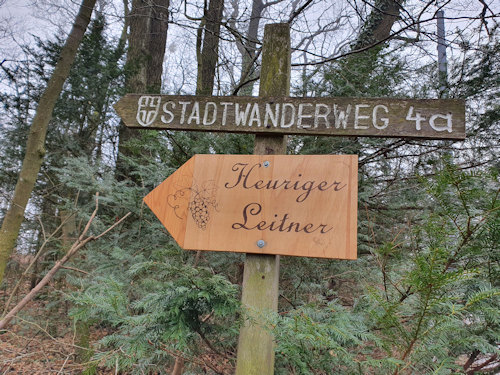
(City walk and refreshment opportunity in one)
A Heuriger is best described as a wine tavern. The typical distinctive features include a rustic look, homegrown wine, a buffet, wooden outdoor seating, and a slowing of time (almost like a rural answer to the coffee house tradition).
Many locals pop out on a summer’s afternoon to sit under a spreading vine for a glass or two of white wine with some bread and cold meats.
You can imagine falling into drowsy contentment as dandelion seeds float past and the sun creates mottled patterns on your table top. Though things can get lively too, particularly with a dose of “Heurigen” music, which may involve an accordion and miscellaneous ribaldry.
The name derives from the idea of “heurigen Wein” (“this year’s wine”) and the Heuriger experience remains a very authentic and traditional one in Vienna, as this 19th-century picture demonstrates:
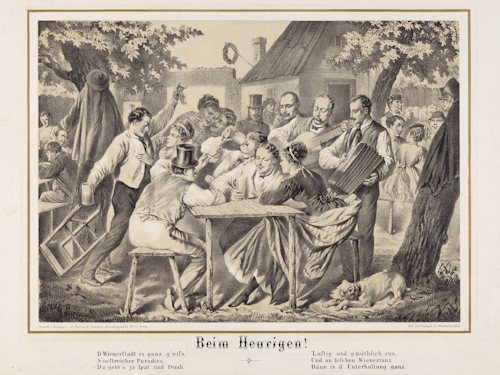
(Beim Heurigen or At the Heuriger from around 1870, published by A. Planck and drawn by August Lanzedelly; Sammlung Wien Museum; reproduced with permission under the terms of the CC0 licence)
The Buschenschank
Not every Heuriger is, however, a “true” Heuriger.
A “genuine” Heuriger (called a Buschenschank) follows requirements closely defined in local law and essentially means somewhere where a vineyard or orchard owner sells their own produce on their own property. That law has its origins in a regulation issued by Emperor Joseph II in 1784.
According to Viennese state legislation, for example, a Buschenschank…
- Must be located in specific, well-defined rural areas of the city
- Cannot open in December and January
- May open for no more than four days in any one week (plus public holidays) the rest of the year
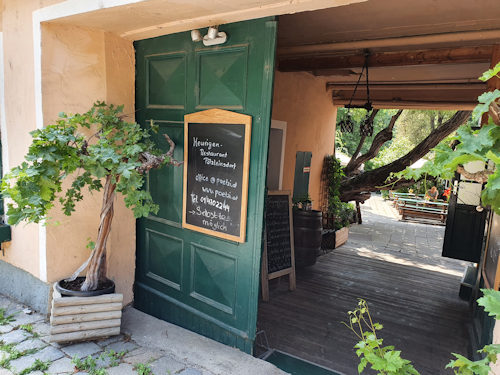
(A typical Heuriger in the outlying hills of Vienna)
The formal Buschenschank only offers wine and fruit-based drinks from their own harvest or spirits they’ve distilled themselves.
And it may only serve a limited range of cold foods (for example, domestic fruit and vegetables, pickles, spreads, domestic cheeses, domestic hams and sausages, and similar).
Only an enterprise officially registered as a Buschenschank can describe itself as such and hang out the traditional sprig of conifer leaves to indicate it’s open for business.
Incidentally, you might wonder how a genuine Heuriger can even open in a city given the homegrown wine requirement. However, Vienna actually has a remarkably large number of vineyards.
The term Heuriger does not enjoy the protected status of the term Buschenschank.
As such, taverns and restaurants that possess many (but not all) of the characteristics of the traditional Buschenschank (rustic decor, a focus on their own homegrown wine, a cold buffet, etc.) may describe themselves as a Heuriger.
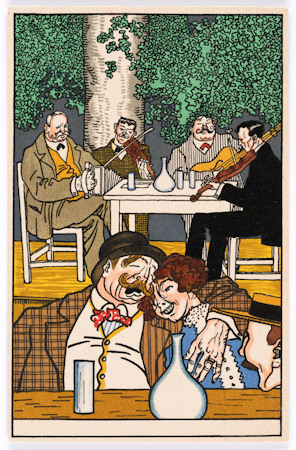
(Artist Moriz Jung’s 1911 depiction of a Heuriger visit in a postcard published by the renowned Wiener Werkstätte; Wien Museum Inv.-Nr. 311175; reproduced with permission under the terms of the CC0 licence)
Some Heuriger are, therefore, as near to Buschenschanks as you can get, but may simply want to open in a more urban area or offer a wider range of drinks or food.
Locals often refer to something called a Stadtheuriger, for example: literally a “town heuriger” located more centrally than the Buschenschank law might allow.
Other Heuriger may just be using the name as marketing simply to imply a certain ambience or image.
Setting and menu

(Wine, dark bread and a pumpkin seed spread. Like the first line of a poem)
A common feature at a Heuriger is the rustic tavern look with wooden tables, chairs, and benches to sit on.
The “Heuriger bench” has even made it into the national vocabulary; garden centres, event suppliers, and DIY stores use the term to sell or provide same-style seating, for example.
Given their traditional raison d’être, the drinks menu normally focuses on wine. White grapes dominate Viennese vineyards, particularly the local, dry Grüner Veltliner variety that goes particularly well in a spritzer.
A typical Heuriger also has a selection of buffet items you can pick and choose from.
Available foods should include a range of breads and spreads, as well as an eclectic cornucopia of local delicacies. Whereby the word delicacy may feel inappropriate to the non-Austrian palate.
So you might enjoy salads, cold Schnitzel, and aromatic cured hams, but also Blunzen (blood sausage or black pudding) and Grammelschmalz (fried bacon bits and lard).
Some Heuriger, particularly in town, offer a more conventional restaurant menu, too.
Where can you find a Heuriger or Buschenschank?
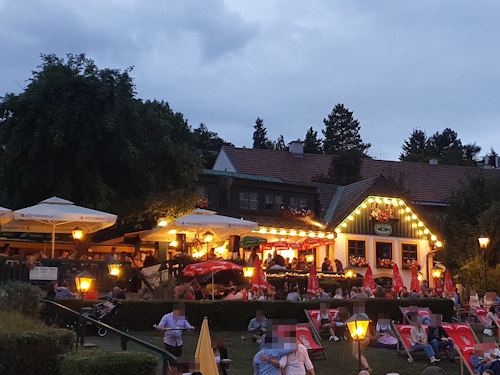
(A Heuriger at the Neustifter Kirtag event)
Heuriger tend to appear on the outskirts of Vienna, particularly (and unsurprisingly) around the city’s wine-growing areas.
However, as mentioned, Vienna has numerous Heuriger (full-blown genuine or otherwise) throughout its urban areas, too (as a quick Google will soon reveal).
The law only allows the genuine Buschenschank variety in the outlying parts of the 10th, 16th, 17th, 18th, 21st and 23rd districts, as well as in the whole of the 19th district.
As that limitation suggests, the hotspots for a traditional Heuriger are in Döbling (the 19th district), particularly among the gentle hills of the Grinzing and Nussdorf suburbs.
Another Döbling Heuriger hotspot is Neustift am Walde, which holds an annual 4-day wine-growing festival in August, with a long street market, live music, and various traditions involving Lederhosen and more.
You can easily get out to Nussdorf by taking the D tram from the centre (e.g. Schottentor station) or reach Grinzing by taking the 38 tram from Schottentor or the U4 subway to Heiligenstadt (then continue on the 38A bus). You want the 35A bus for Neustift am Walde.
Should you do so, then Zum Wohl! (“To your good health” – a typical sentiment expressed on raising a glass of wine in Austria).
